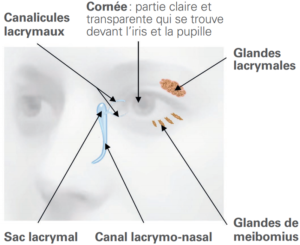Our eyes are moistened by lacrimal glands that produce tears - composed of lipids, water, mucus, proteins and salt - to nourish, protect, clean and moisturize the eye. The tears are distributed by the blinking of the eyelids and form a film that keeps the cornea moist and smooth.
Dry eye syndrome is a condition that occurs when the quality or quantity of tears is insufficient, or when the tear film is fragile. Although it is often pointed out, tear deficiency is rarely the cause. It is often a dysfunction of the Meibomius glands, which are responsible for the production of the lipid film and whose role is to prevent the evaporation of tears.
Dry eye, a chronic multifactorial disease, causes symptoms of discomfort, visual disturbance and instability of the tear film. It manifests itself through various symptoms that can lead to vision problems: dry eyes, redness, a sensation of sand grains, burning, tearing, itching, sensitivity to light, secretions, fatigue, reduced vision or blurred vision, especially when reading or using a screen.
Rarely serious but often very uncomfortable, dry eye syndrome can still lead to corneal deterioration and threaten vision.
Currently, the treatments available to patients are eyelid hygiene, artificial tears or lubricating eye drops.
Prevention, through a few easy-to-implement gestures and habits, can reduce the risks:
> Blink often
> Clean the eyes and remove make-up
> Protect your eyes from the sun, dust and drafts
> Avoid smoking or being exposed to smoke
> Humidify the air in the house in winter
> Have regular check-ups with a specialist
